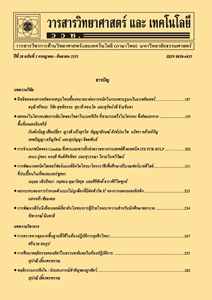Energy Efficiency Analysis in Solid Oxide Electrolysis Cell System for Production of Hydrogen, Methane and Methanol
Main Article Content
Abstract
This research aims to study the solid oxide electrolysis cell (SOEC) system with methane synthesis and methanol synthesis. Exhaust gas from the coal power plant was used as feedstock. These processes were designed and simulated by Aspen plus v.9.0. The developed model was employed to study the optimal operating conditions, generating the maximum product yields and the highest energy efficiency. The effect of several parameters including SOEC temperature and pressure (550-1,000 ºC, 1-30 bar), methane synthesis temperature and pressure (200-600 ºC, 1-100 bar), and methanol synthesis temperature and pressure (140-280 ºC, 15-100 bar) were investigated with energy efficiency analysis. The simulation results showed that the optimal operating conditions which provided the maximum hydrogen production were SOEC temperature of 800 ºC, pressure of 1 bar, and energy efficiency of 14.95 %. The optimal operating conditions for methane synthesis were temperature of 200 ºC, pressure of 1 bar, and energy efficiency of 69.97 %. The optimal operating conditions for methanol synthesis were temperature of 160 ºC, pressure of 100 bar, and energy efficiency of 75.42 %.
Article Details
References
Parigi, D., Giglio, E., Soto, A. and Santarelli, M., 2019, Power-to-fuels through carbon dioxide re-utilization and high temperature electrolysis: A technical and economical comparison between synthetic methanol and methane, J. Clean. Prod. 226: 679-691.
Bozzano, G. and Manenti, F., 2016, Efficient methanol synthesis: Perspectives, technologies and optimization strategies, Prog. Energy Combust. Sci. 56: 71-105.
Andika, R., Nandiyanto, A.B., Putra, Z.A., Bilad, M.R., Kim, Y., Yun, C.M. and Lee, M., 2018, Co-electrolysis for power-to-methanol applications, Renew. Sustain. Energy Rev. 95: 227-241.
Redissi, Y. and Bouallou, C., 2013, Valorization of carbon dioxide by co-electrolysis of CO2/H2O at high temperature for syngas production, Energy Proc. 37: 6667–6678.
Van-Dal, E.S. and Bouallou, C., 2013, Design and simulation of a methanol production plant from CO2 hydrogenation, J. Clean. Prod. 57: 38-45.
Sharifian, S. and Harasek, M., 2015, Simulation of COX Methanation Reactor for the Production of Natural Gas, Chem. Eng. Transact. 45: 1003-1008.
Nattawut, W. and Amornchai, A., 2014, Electrolysis for hydrogen production, Technol. Promot. Innomag Magazine 237: 45-48. (in Thai)
Wang, L., Rao, M., Diethelm, S., Lin, T., Zhang, H., Hagen, A. and van Herle, J., 2019, Power-to-methane via co-electrolysis of H2O and CO2: The effects of pressurized operation and internal methanation, Appl. Energy 250: 1432-1445.
Stempien, J.P., Ding, O.L., Sun, Q. and Chan, S.H., 2012, Energy and exergy analysis of solid oxide electrolyser cell (SOEC) working as a CO2 mitigation device, Int. J. Hydrogen Energy 37: 14518-14527.
Pozzo, M., Lanzin, A. and Santarelli, M., 2015, Enhanced biomass-to-liquid (BTL) conversion process through high tempera ture co-electrolysis in a solid oxide electrolysis cell (SOEC), Fuel 145: 39-49.
Tinoco, R.R., Farran, M., Bouallou, C., Aupretre, F., Valentin, S., Millet, P. and Ngameni, J.R., 2016, Investigation of power-to-methanol processes coupling electrolytic hydrogen production and catalytic CO2 reduction, Int. J. Hydrogen Energy 41: 4546-4559.
Li, W., Wang, H., Shi, Y. and Cai, N., 2013, Performance and methane production characteristics of H2O-CO2 co-electrolysis in solid oxide electrolysis cells, Int. J. Hydrogen Energy 38: 11104-11109.
Er-rbib, H. and Bouallou, C., 2013, Modelling and simulation of methanation catalytic reactor for renewable electricity storage. Chem. Eng. Transact 35: 541-546.
Porubova, J., Bazbauers, G. and Markova, D., 2011, Modeling of the adiabatic and isothermal methanation process, Sci. J. Riga Tech. Univer. 6: 79-84.
Kim, W.S., Yang, D.R., Moon, D.J. and Ahn, B.S., 2014, The process design and simulation for the methanol production on the FPSO (floating production, storage and off-loading) system, Chem. Eng. Res. Design 92: 931-940.
Rujiroj, T., Rujira, J., Tarawipa, P., Weerawat, P. and Kamonrat, L., 2018, Kinetic modeling and simulation of bio-methanol process from biogas by using aspen plus, MATEC Web Conf. 192: 3030-3034.
Mignard, D. and Pritchard, C., 2008, On the use of electrolytic hydrogen from variable renewable energies for the enhanced conversion of biomass to fuels, Chem. Eng. Res. Design 86: 473-487.
Lonis, F., Tola, V. and Cau, G., 2019, Renewable methanol production and use through reversible solid oxide cells and recycled CO2 hydrogenation, Fuel 246: 500-515.
Kang, W.R. and Lee, K.B., 2013, Effect of operating parameters on methanation reaction for the production of synthetic natural gas, Korean J. Chem. Eng. 30: 1386-1394.
Lücking, L.E., 2017, Methanol Production from Syngas: Process Modelling and Design Utilizing Biomass Gasification and Integrating Hydrogen Supply, Delft University of Technology, Mekelweg.
Puig-Gamero, M., Argudo-Santamaria, J., Valverde, J.L., Sánchez, P. and Sanchez-Silva, L., 2018, Three integrated process simulation using aspen plus®: Pine gasification, syngas cleaning and methanol synthesis, Energy Convers Manag. 177: 416-427.


